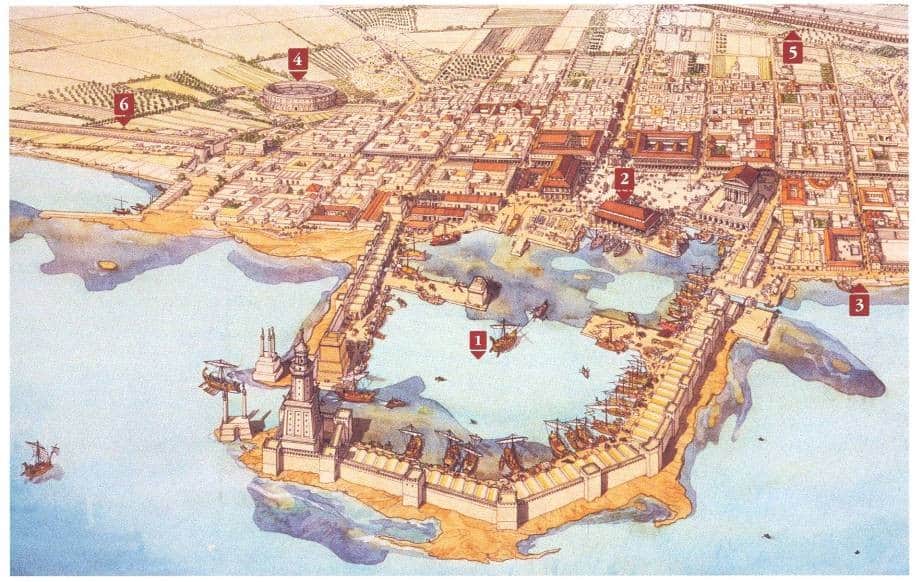After the death of Herod the Great (4 BCE), Caesarea became the seat of the Roman commissioners or “Procurators” of Judea. Caesarea had a mixed population, but with a distinctly foreign character. The Jewish residents of Caesarea often suffered harassment from their foreign neighbors, and there was constant tension between the local Jews, Greeks and Romans. In 66 CE, a chain of events near the synagogue in Caesarea led to bloody riots, which signaled the beginning of the Great Revolt. Sources refer to the synagogue as The Synagogue of “Demarduta” (or “Rebellion.”) During the Bar Kochba revolt, Caesarea was the main supply base for the Roman army, and later several of the Ten Martyrs were executed in Caesarea, including Rabbi Akiva. Emperor Vespasian elevated Caesarea to the rank of a Colonia with limited rights, and later Caesarea was given the title “Metropolis”. The Jewish community in Caesarea strengthened during the Middle Roman period, and was an important center for Judaism.
Roman Caesarea – Restoration

Finds from the Roman period
Under the rule of the procurators, Caesarea became the capital of the province of Judea. During this period, the city expanded to the east and various public buildings were built. The temple continued to be used as the Temple of Rome and Augustus, and was named “Sebastos”- the Greek name for Augustus. Herod’s palace was converted to serve as the seat of the Roman governors. During this period, various office rooms were added, as well as a bath house with a brick floor imprinted with the seal of the Tenth Legion, “Partensis.” To the south of the palace was an area with villas belonging to wealthy land owners (in the Sharon area). Each villa had an associated warehouse section to the north, as well as underground granaries.


A Hippodrome (an ancient Greek stadium, known in Roman terms as a “Circus”) was inspired by the Circus Maximus in Rome, and was built in Caesarea in the days of Emperor Hadrian. The structure had an area of 31,500 square meters and continued to be in use until the 6th century CE. The structure was intended for chariot racing and was surrounded by a system of organized groups, clubs, etc. The circus is located to the east of the city, in a large area which had not been used for construction. In the past, there was an array of kurkar stone seats, which at some point were stolen, but evidence was found when an array of vaults which had supported the seats was exposed. The spina (barrier) consisted of an array of pools along its length, and an obelisk stood at the center. The obelisk was made of Aswan granite stone and was imported from Egypt. The cones placed in the corners of the spina were also exposed.


The Ancient Synagogue
The story of the ancient synagogue in Caesarea is a complementary piece in the cultural mosaic of the extensive Jewish community. The Jews lived in the pagan city, alongside the dominant Roman culture since the first century CE. They observed religion in synagogues within the city, moving between openness and segregation as they coped with changes that came from overseas. Greek was the common language, including in prayers within the synagogues. It was in Caesarea that the initial fire of the Great Revolt was ignited and spread throughout Judea. Ten Jewish martyrs met their deaths here; the most famous one being Rabbi Akiva.
The Mother of Pearl Slab (Archaeological Excavations of 2018)
Caesarea was an important Jewish center during the Roman and Byzantine periods. A small plaque made of mother of pearl was discovered with an engraving of a seven-branched lamp (menorah) and an incense shovel. The plaque is evidence of Jewish life in Caesarea since Herod founded the city.


The synagogue complex was first discovered in 1944 during an archeological excavation. Finds with distinct Jewish symbols were uncovered such as mosaics with Greek inscriptions, a marble pillar with the word ”peace” and three inscribed marble fragments from the list of 24 shifts that priestly families (Cohanim) served in rotation in Jerusalem’s Beit Hamikdash/Second Temple. These lists also served as a calendar of rituals performed in the synagogues. A surviving section of a Greek inscription in the mosaic floor of the synagogue reads: “Julius [who] fulfills a vow.” Julius apparently made a significant donation for the construction of the synagogue. (4th-5th centuries CE).